Page 197 of 527
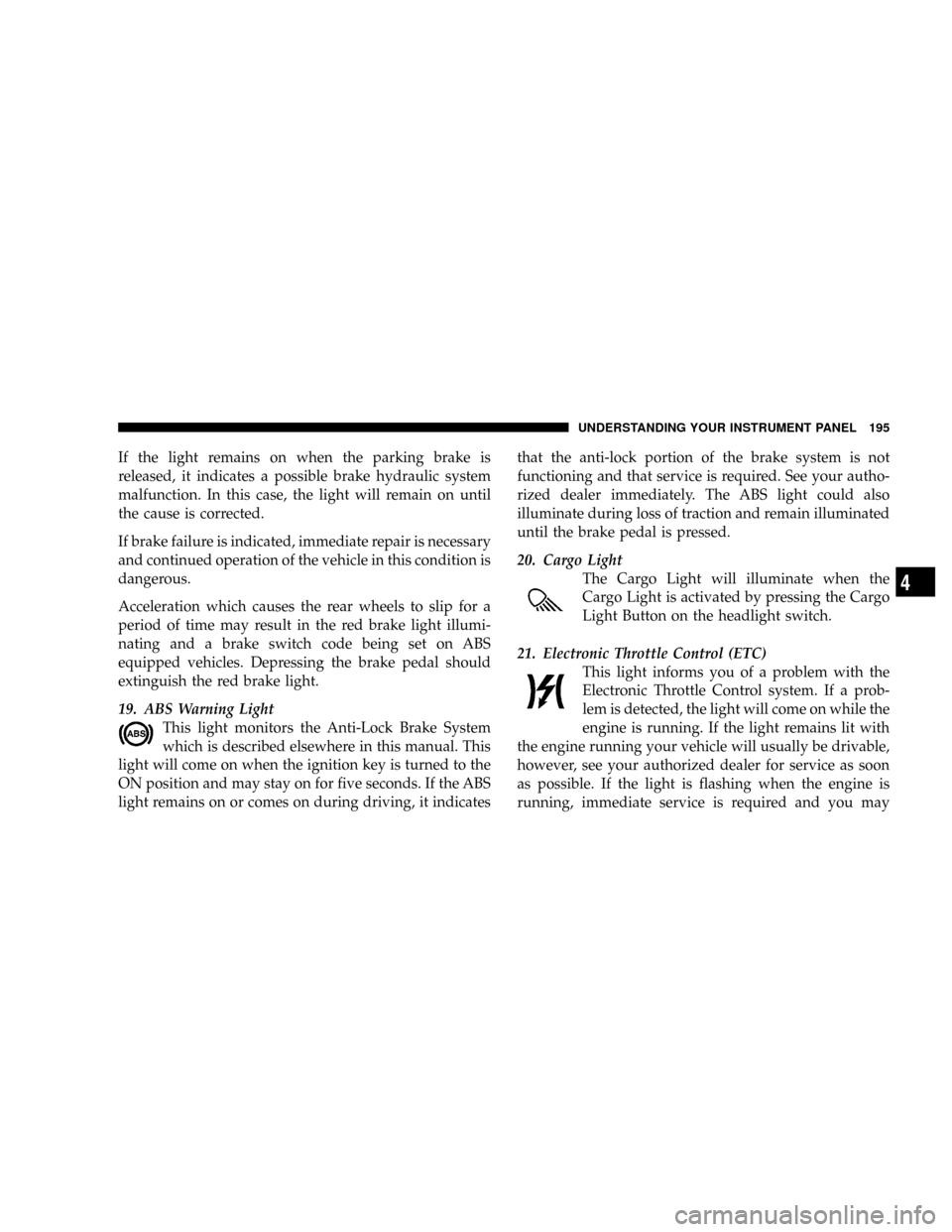
If the light remains on when the parking brake is
released, it indicates a possible brake hydraulic system
malfunction. In this case, the light will remain on until
the cause is corrected.
If brake failure is indicated, immediate repair is necessary
and continued operation of the vehicle in this condition is
dangerous.
Acceleration which causes the rear wheels to slip for a
period of time may result in the red brake light illumi-
nating and a brake switch code being set on ABS
equipped vehicles. Depressing the brake pedal should
extinguish the red brake light.
19. ABS Warning Light
This light monitors the Anti-Lock Brake System
which is described elsewhere in this manual. This
light will come on when the ignition key is turned to the
ON position and may stay on for five seconds. If the ABS
light remains on or comes on during driving, it indicatesthat the anti-lock portion of the brake system is not
functioning and that service is required. See your autho-
rized dealer immediately. The ABS light could also
illuminate during loss of traction and remain illuminated
until the brake pedal is pressed.
20. Cargo Light
The Cargo Light will illuminate when the
Cargo Light is activated by pressing the Cargo
Light Button on the headlight switch.
21. Electronic Throttle Control (ETC)
This light informs you of a problem with the
Electronic Throttle Control system. If a prob-
lem is detected, the light will come on while the
engine is running. If the light remains lit with
the engine running your vehicle will usually be drivable,
however, see your authorized dealer for service as soon
as possible. If the light is flashing when the engine is
running, immediate service is required and you may
UNDERSTANDING YOUR INSTRUMENT PANEL 195
4
Page 265 of 527
STARTING AND OPERATING
CONTENTS
mStarting Procedures ± Diesel Engines.........268
NAutomatic Transmission ± If Equipped......268
NManual Transmission ± If Equipped........269
NNormal Starting Procedure ± Engine Manifold
Air Temperature Above 66ÉF (19ÉC)........269
NStarting Procedure ± Engine Manifold Air
Temperature Below 66ÉF (19ÉC)...........270
NStarting Fluids.......................274
mNormal Operation (Diesel Engine)...........274
NCold Weather Precautions...............275NEngine Idling........................278
NStopping The Engine...................280
NEngine Speed Control..................281
NOperating Precautions..................281
NCooling System Tips Ð Automatic
Transmission........................281
mDiesel Exhaust Brake (Engine Braking) ±
If Equipped...........................283
mTransmission Shifting....................285
NAutomatic Transmission With Overdrive
(68RFE) Ð If Equipped.................285
5
Page 266 of 527
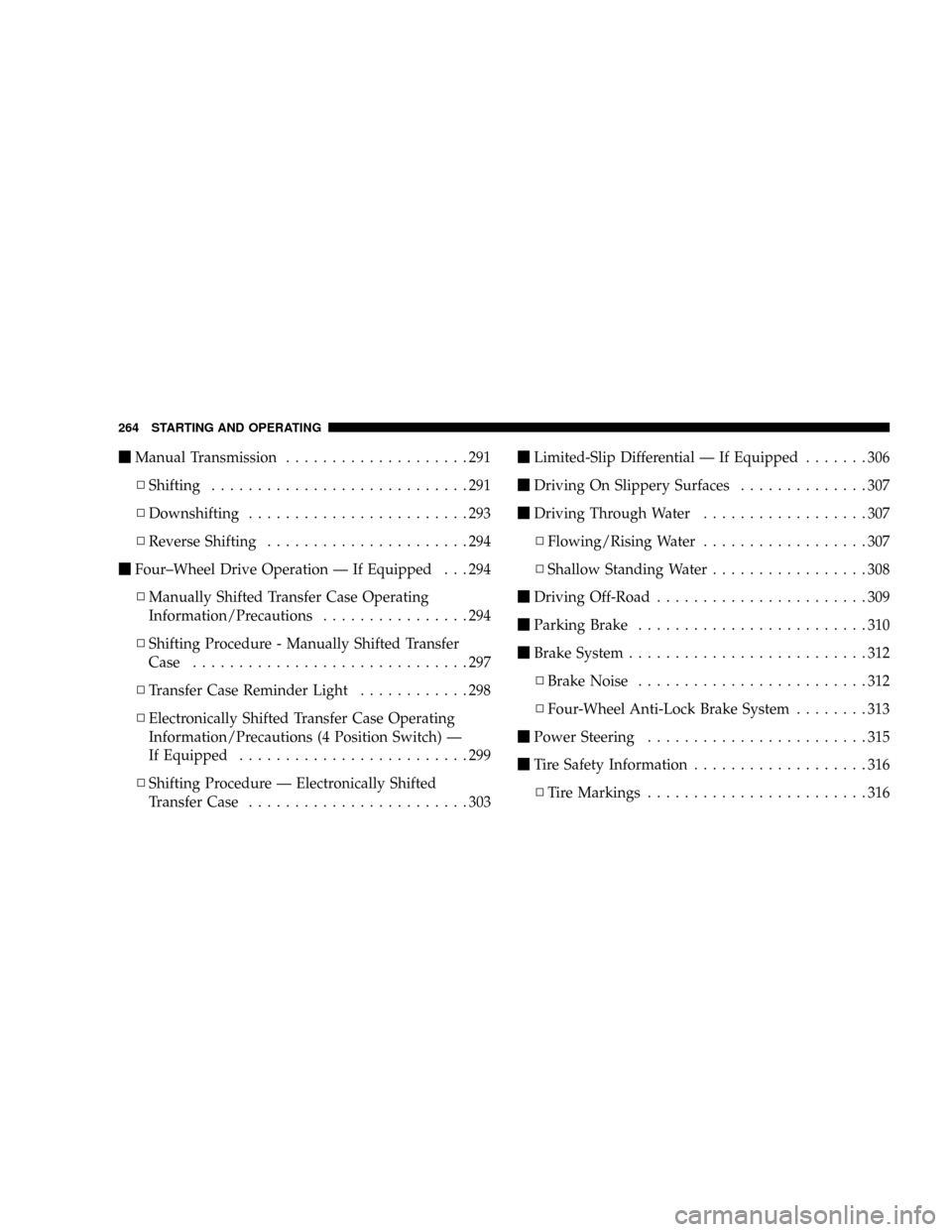
mManual Transmission....................291
NShifting............................291
NDownshifting........................293
NReverse Shifting......................294
mFour±Wheel Drive Operation Ð If Equipped . . . 294
NManually Shifted Transfer Case Operating
Information/Precautions................294
NShifting Procedure - Manually Shifted Transfer
Case..............................297
NTransfer Case Reminder Light............298
NElectronically Shifted Transfer Case Operating
Information/Precautions (4 Position Switch) Ð
If Equipped.........................299
NShifting Procedure Ð Electronically Shifted
Transfer Case........................303mLimited-Slip Differential Ð If Equipped.......306
mDriving On Slippery Surfaces..............307
mDriving Through Water..................307
NFlowing/Rising Water..................307
NShallow Standing Water.................308
mDriving Off-Road.......................309
mParking Brake.........................310
mBrake System..........................312
NBrake Noise.........................312
NFour-Wheel Anti-Lock Brake System........313
mPower Steering........................315
mTire Safety Information...................316
NTire Markings........................316
264 STARTING AND OPERATING
Page 270 of 527
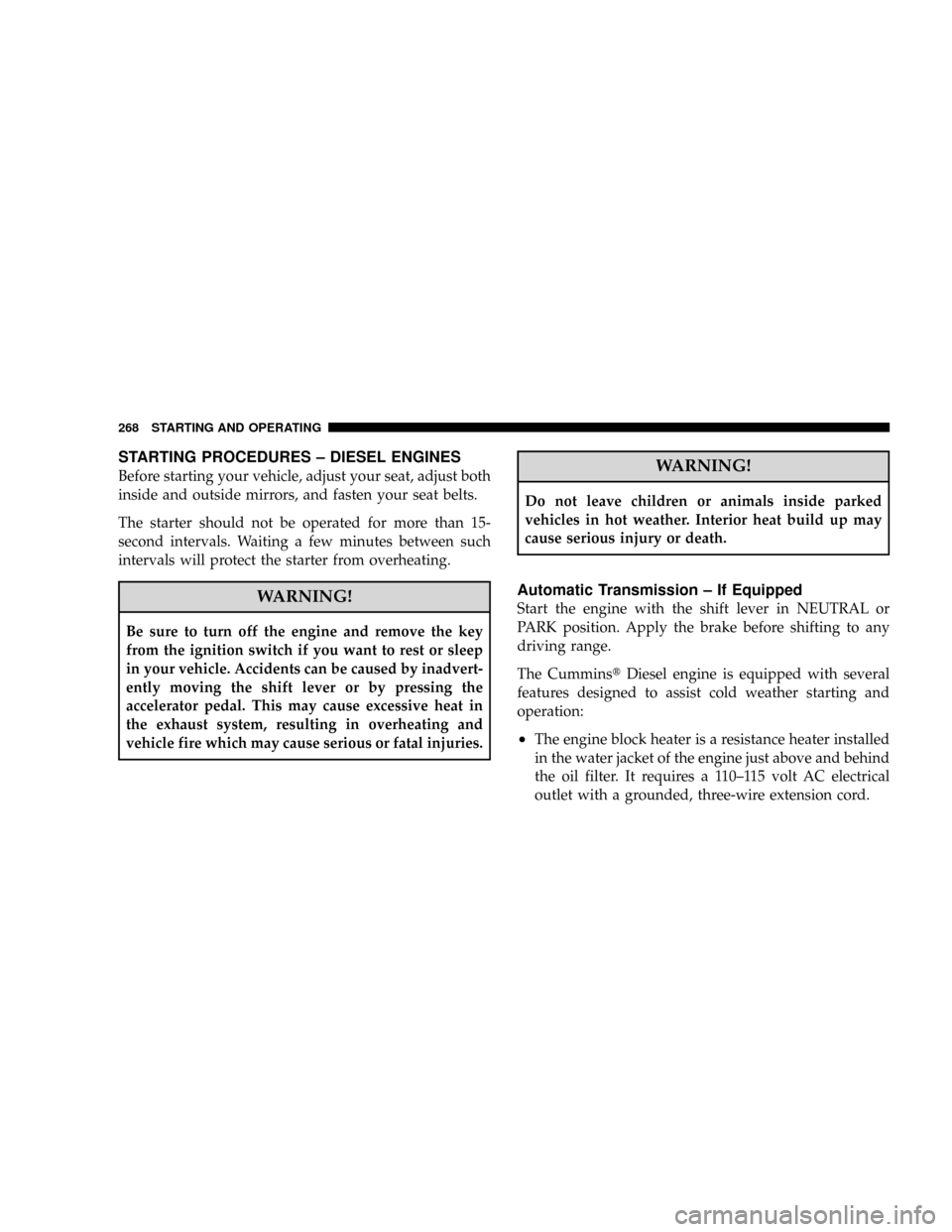
STARTING PROCEDURES ± DIESEL ENGINES
Before starting your vehicle, adjust your seat, adjust both
inside and outside mirrors, and fasten your seat belts.
The starter should not be operated for more than 15-
second intervals. Waiting a few minutes between such
intervals will protect the starter from overheating.
WARNING!
Be sure to turn off the engine and remove the key
from the ignition switch if you want to rest or sleep
in your vehicle. Accidents can be caused by inadvert-
ently moving the shift lever or by pressing the
accelerator pedal. This may cause excessive heat in
the exhaust system, resulting in overheating and
vehicle fire which may cause serious or fatal injuries.
WARNING!
Do not leave children or animals inside parked
vehicles in hot weather. Interior heat build up may
cause serious injury or death.
Automatic Transmission ± If Equipped
Start the engine with the shift lever in NEUTRAL or
PARK position. Apply the brake before shifting to any
driving range.
The CumminstDiesel engine is equipped with several
features designed to assist cold weather starting and
operation:
²The engine block heater is a resistance heater installed
in the water jacket of the engine just above and behind
the oil filter. It requires a 110±115 volt AC electrical
outlet with a grounded, three-wire extension cord.
268 STARTING AND OPERATING
Page 271 of 527
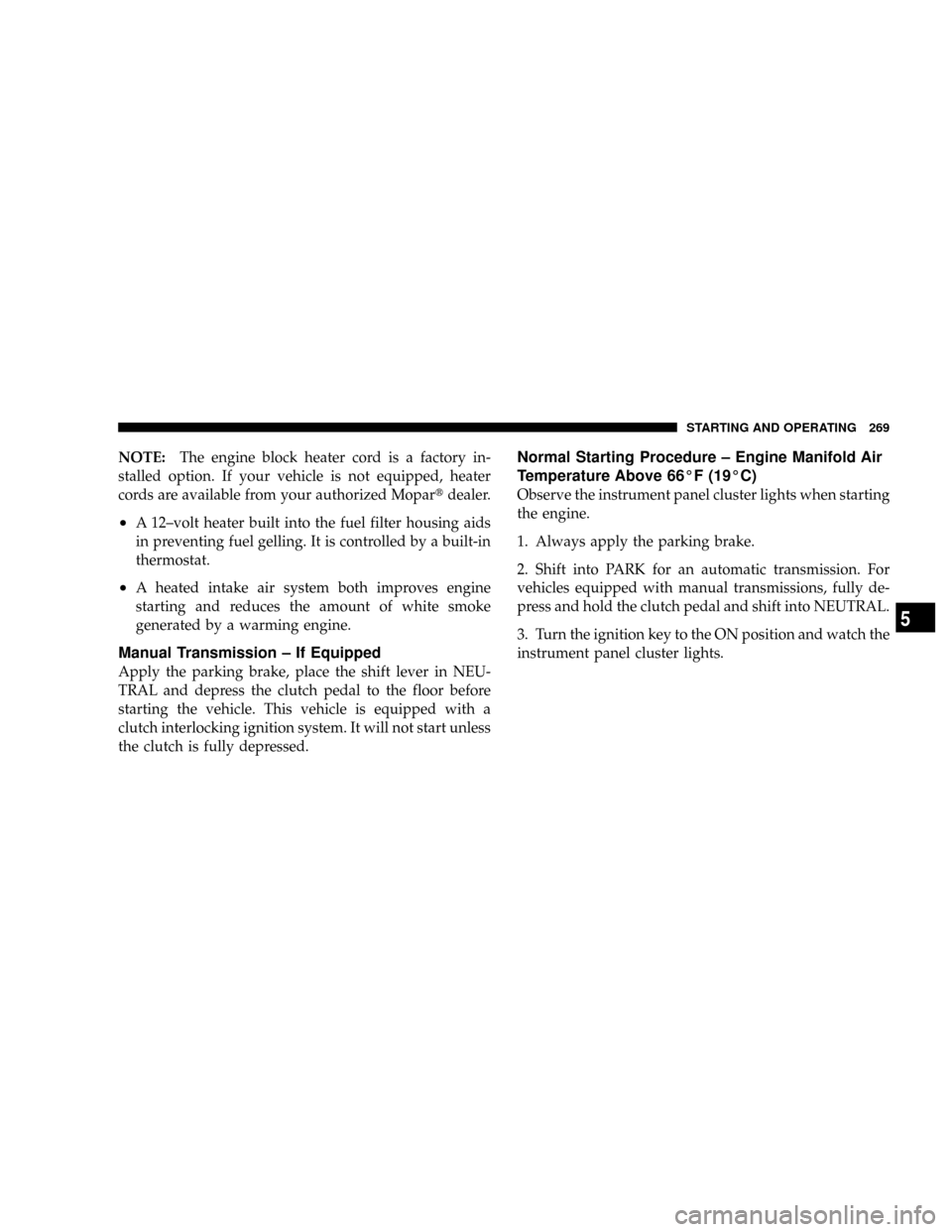
NOTE:The engine block heater cord is a factory in-
stalled option. If your vehicle is not equipped, heater
cords are available from your authorized Mopartdealer.
²A 12±volt heater built into the fuel filter housing aids
in preventing fuel gelling. It is controlled by a built-in
thermostat.
²A heated intake air system both improves engine
starting and reduces the amount of white smoke
generated by a warming engine.
Manual Transmission ± If Equipped
Apply the parking brake, place the shift lever in NEU-
TRAL and depress the clutch pedal to the floor before
starting the vehicle. This vehicle is equipped with a
clutch interlocking ignition system. It will not start unless
the clutch is fully depressed.
Normal Starting Procedure ± Engine Manifold Air
Temperature Above 66ÉF (19ÉC)
Observe the instrument panel cluster lights when starting
the engine.
1. Always apply the parking brake.
2. Shift into PARK for an automatic transmission. For
vehicles equipped with manual transmissions, fully de-
press and hold the clutch pedal and shift into NEUTRAL.
3. Turn the ignition key to the ON position and watch the
instrument panel cluster lights.
STARTING AND OPERATING 269
5
Page 272 of 527
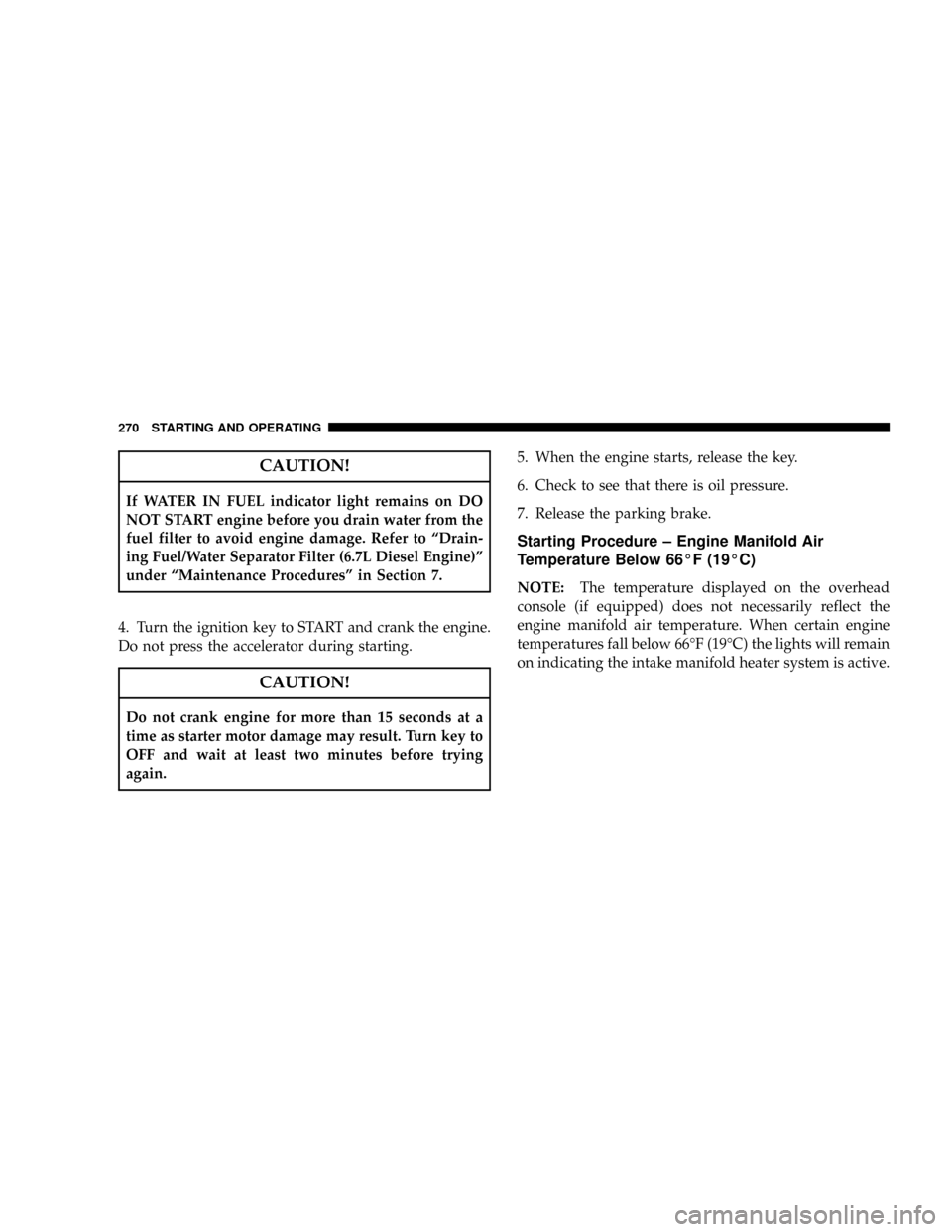
CAUTION!
If WATER IN FUEL indicator light remains on DO
NOT START engine before you drain water from the
fuel filter to avoid engine damage. Refer to ªDrain-
ing Fuel/Water Separator Filter (6.7L Diesel Engine)º
under ªMaintenance Proceduresº in Section 7.
4. Turn the ignition key to START and crank the engine.
Do not press the accelerator during starting.
CAUTION!
Do not crank engine for more than 15 seconds at a
time as starter motor damage may result. Turn key to
OFF and wait at least two minutes before trying
again.5. When the engine starts, release the key.
6. Check to see that there is oil pressure.
7. Release the parking brake.
Starting Procedure ± Engine Manifold Air
Temperature Below 66ÉF (19ÉC)
NOTE:The temperature displayed on the overhead
console (if equipped) does not necessarily reflect the
engine manifold air temperature. When certain engine
temperatures fall below 66ÉF (19ÉC) the lights will remain
on indicating the intake manifold heater system is active.
270 STARTING AND OPERATING
Page 273 of 527
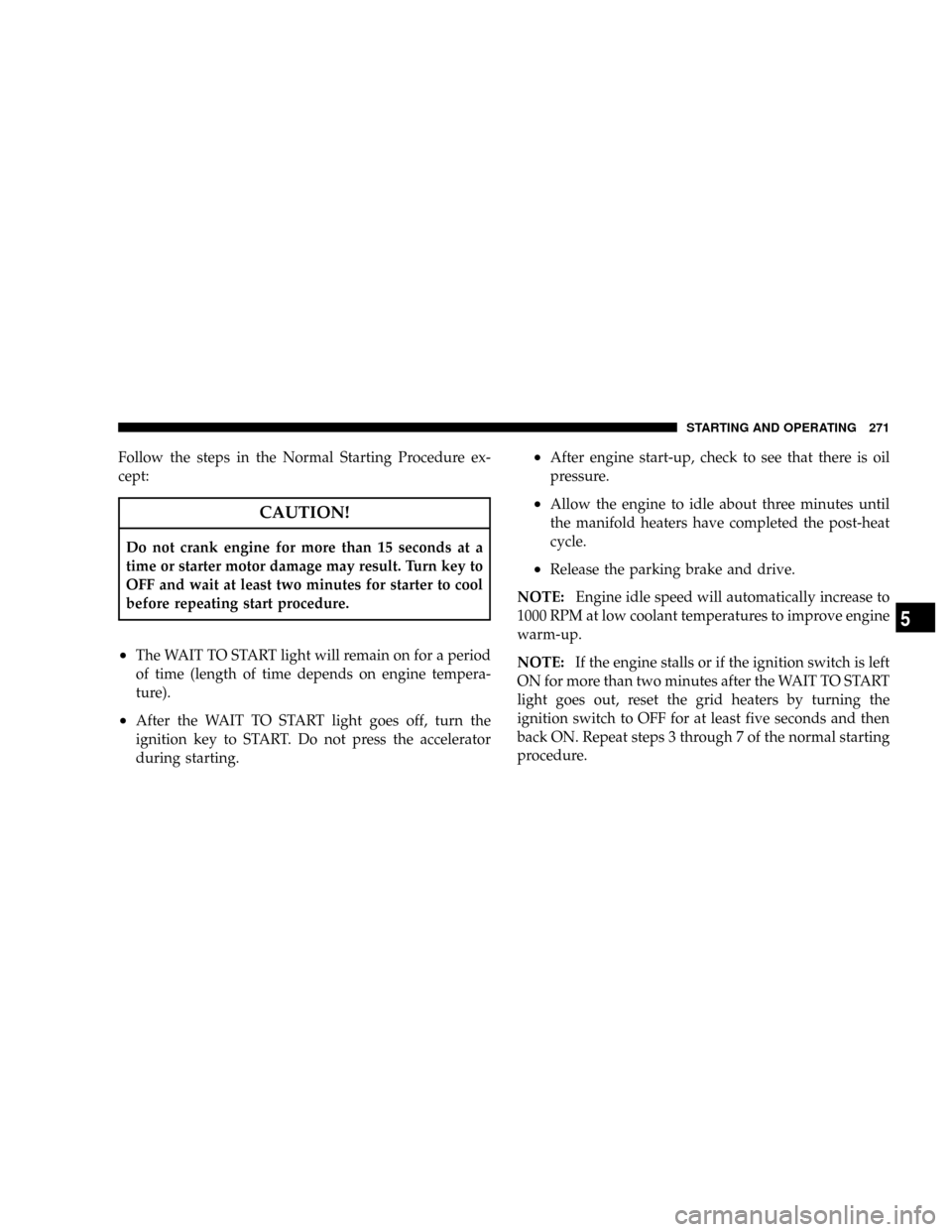
Follow the steps in the Normal Starting Procedure ex-
cept:
CAUTION!
Do not crank engine for more than 15 seconds at a
time or starter motor damage may result. Turn key to
OFF and wait at least two minutes for starter to cool
before repeating start procedure.
²The WAIT TO START light will remain on for a period
of time (length of time depends on engine tempera-
ture).
²After the WAIT TO START light goes off, turn the
ignition key to START. Do not press the accelerator
during starting.
²After engine start-up, check to see that there is oil
pressure.
²Allow the engine to idle about three minutes until
the manifold heaters have completed the post-heat
cycle.
²Release the parking brake and drive.
NOTE:Engine idle speed will automatically increase to
1000 RPM at low coolant temperatures to improve engine
warm-up.
NOTE:If the engine stalls or if the ignition switch is left
ON for more than two minutes after the WAIT TO START
light goes out, reset the grid heaters by turning the
ignition switch to OFF for at least five seconds and then
back ON. Repeat steps 3 through 7 of the normal starting
procedure.
STARTING AND OPERATING 271
5
Page 281 of 527
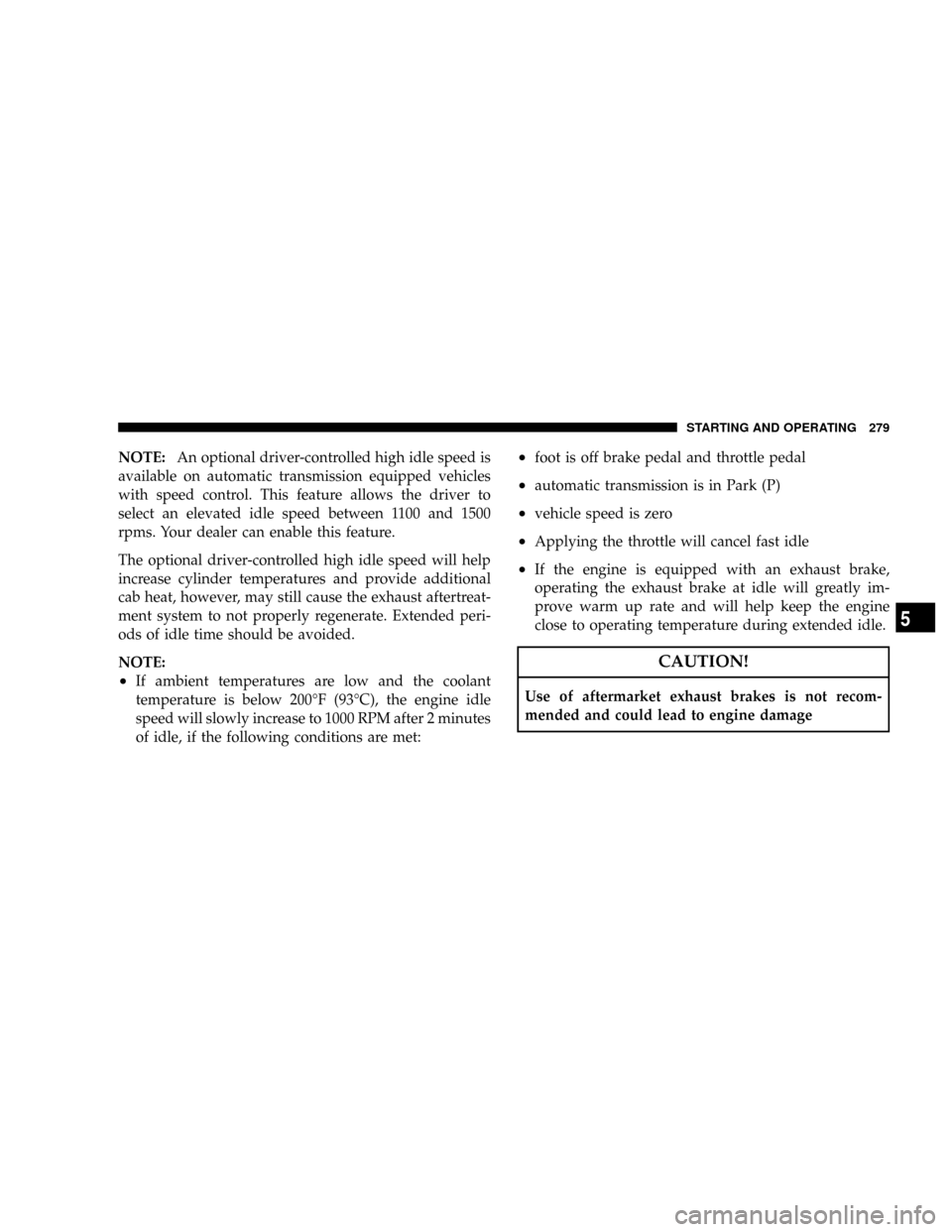
NOTE:An optional driver-controlled high idle speed is
available on automatic transmission equipped vehicles
with speed control. This feature allows the driver to
select an elevated idle speed between 1100 and 1500
rpms. Your dealer can enable this feature.
The optional driver-controlled high idle speed will help
increase cylinder temperatures and provide additional
cab heat, however, may still cause the exhaust aftertreat-
ment system to not properly regenerate. Extended peri-
ods of idle time should be avoided.
NOTE:
²If ambient temperatures are low and the coolant
temperature is below 200ÉF (93ÉC), the engine idle
speed will slowly increase to 1000 RPM after 2 minutes
of idle, if the following conditions are met:
²foot is off brake pedal and throttle pedal
²automatic transmission is in Park (P)
²vehicle speed is zero
²Applying the throttle will cancel fast idle
²If the engine is equipped with an exhaust brake,
operating the exhaust brake at idle will greatly im-
prove warm up rate and will help keep the engine
close to operating temperature during extended idle.
CAUTION!
Use of aftermarket exhaust brakes is not recom-
mended and could lead to engine damage
STARTING AND OPERATING 279
5